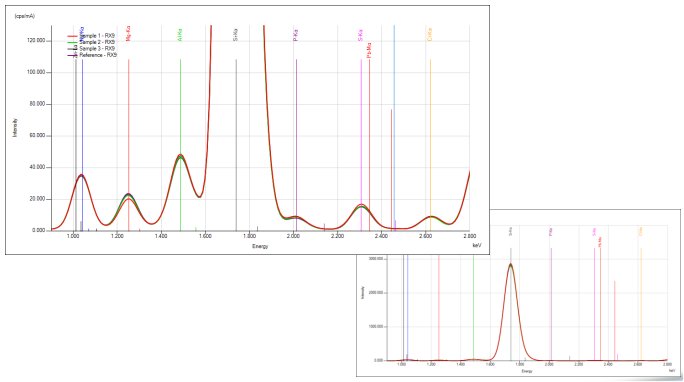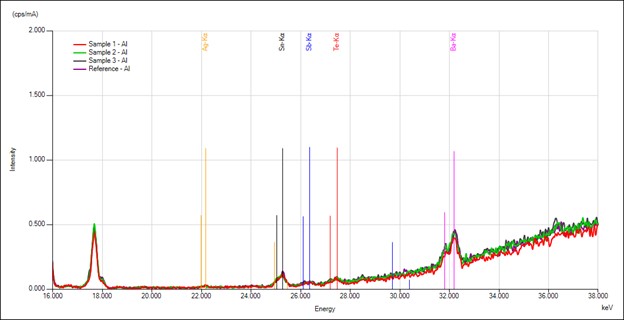Application Note EDXRF1853
Scope
The analysis of fiberglass is demonstrated.
Background
 Fiberglass, also called glass wool, is used to make thermal insulation for houses, buildings, piping and ducts, and can also be used as a soundproofing material. Fiberglass-reinforced plastic is used to produce thermosetting polymers to make swimming pools, hot tubs, water tanks and surfboards, among many other types of products. Various fiberglass formulations are used which require elemental composition analysis to ensure proper physical and chemical properties during the manufacturing of fiberglass. Applied Rigaku Technologies offers NEX CG EDXRF analyzer to meet this industry need. Simple to use, this non-destructive technique is fast with minimal sample preparation to give optimum measurement of elements in fiberglass for at-line quality control, QA/QC lab work and the more demanding work of R&D.
Fiberglass, also called glass wool, is used to make thermal insulation for houses, buildings, piping and ducts, and can also be used as a soundproofing material. Fiberglass-reinforced plastic is used to produce thermosetting polymers to make swimming pools, hot tubs, water tanks and surfboards, among many other types of products. Various fiberglass formulations are used which require elemental composition analysis to ensure proper physical and chemical properties during the manufacturing of fiberglass. Applied Rigaku Technologies offers NEX CG EDXRF analyzer to meet this industry need. Simple to use, this non-destructive technique is fast with minimal sample preparation to give optimum measurement of elements in fiberglass for at-line quality control, QA/QC lab work and the more demanding work of R&D.
 Model: NEX CG
Model: NEX CG
Rigaku Fundamental Parameters (FP) and Matching Libraries
The Rigaku FP approach allows for screening and semi-quant measurements without the need for any assayed reference samples. Software templates guide the user through simple method set-up using flow bar design with analytical measurement parameters determined automatically for best measurement of each sample.
Rigaku RPF-SQX FP uses advanced whole-spectrum fitting going beyond standard Gaussian fitting techniques to deconvolute overlapping peaks, thus providing optimum net intensities for use in FP. Rigaku FP then uses advanced mathematical modelling to determine semi-quant concentration results. Rigaku Scattering FP can be selected to optimize the calculation of the unmeasurable components in XRF when more than one balance component is present in the material.
Analytical accuracy of semi-quant FP measurements may be improved and made fully quantitative using Rigaku Matching Library methodology included in the software. Using one or only a few samples with known elemental concentrations determined by an accepted referee technique, a Matching Library is used in conjunction with the FP package to provide a matrix-matched example of the actual to optimize the modeling of the matrix. Matching Libraries are easily created by the user by simply registering one or more assayed standards in the library to adjust theoretical intensities to measured intensities of a known sample.

1-point Matching Library for Si in fiberglass
Results
One sample with elemental composition assayed by ICP was used as a reference type standard to create a single-point Matching Library. The results here show the measurements of three unknown fiberglass samples. While boron cannot be measured by EDXRF, this example shows a known amount of boron oxide with the known, fixed amount entered by the operator.
| Sample ID: 1 Units: Mass% | ||
| Component | NEX CG value | Stat.error |
| Na₂O | 16.1 | 0.1 |
| MgO | 2.60 | 0.03 |
| Al₂O₃ | 1.28 | 0.01 |
| SiO₂ | 65.7 | Balance |
| P₂O₅ | 0.138 | 0.001 |
| SO₃ | 0.181 | 0.001 |
| K₂O | 0.607 | 0.005 |
| CaO | 8.16 | 0.02 |
| TiO₂ | 0.102 | 0.001 |
| MnO | 0.202 | 0.002 |
| Fe₂O₃ | 0.161 | 0.002 |
| B₂O3*** | 4.85 | Fixed |
| Sample ID: 2 Units: Mass% |
||
| Component | NEX CG value | Stat. error |
| Na₂O | 16.4 | 0.1 |
| MgO | 2.94 | 0.03 |
| Al₂O₃ | 1.22 | 0.01 |
| SiO₂ | 65.1 | Balance |
| P₂O₅ | 0.133 | 0.001 |
| SO₃ | 0.173 | 0.001 |
| K₂O | 0.623 | 0.005 |
| CaO | 8.08 | 0.02 |
| TiO₂ | 0.0895 | 0.0013 |
| MnO | 0.183 | 0.002 |
| Fe₂O3 | 0.189 | 0.002 |
| B₂O3*** | 4.85 | Fixed |
| Sample ID: 3 Units: Mass% |
||
| Component | NEX CG value | Stat. error |
| Na₂O | 16.0 | 0.1 |
| MgO | 2.95 | 0.03 |
| Al₂O₃ | 1.18 | 0.01 |
| SiO₂ | 65.7 | Balance |
| P₂O₅ | 0.123 | 0.001 |
| SO₃ | 0.167 | 0.001 |
| K₂O | 0.608 | 0.005 |
| CaO | 8.04 | 0.02 |
| TiO₂ | 0.0836 | 0.0012 |
| MnO | 0.183 | 0.002 |
| Fe₂O₃ | 0.199 | 0.002 |
| B₂O₃*** | 4.85 | Fixed |
Spectra: Qualitative comparative analysis
The following select spectra show the reference sample and three unknown samples overlapped for comparative analysis, demonstrating the ultra-low flat background, sharp resolution and exceptional sensitivity provided by NEX CG indirect excitation using secondary targets and polarization.

Special target for the optimization of the ultra-light elements Na and Mg
 RX9 target (HOPG Polarizer)
RX9 target (HOPG Polarizer)
 Cu Target
Cu Target
 Mo Target Zoom View
Mo Target Zoom View
 Al Target for Heavy Elements
Al Target for Heavy Elements
Conclusions
The NEX CG EDXRF analyzer provides characterization of majors, minors and trace components in fiberglass samples. The NEX CG utilizes secondary excitation and polarization to achieve excellent sensitivity and ultra-low detection limits. The RPF-SQX FP software package allows for the semi-quant analysis sample composition without the need for assayed reference materials. Alternatively, with one or more assayed samples the user has the flexibility to develop Matching Libraries or empirical calibrations for a fully quantitative approach. The Rigaku NEX CG is an ideal tool for at-line quality control as well as in the lab for the full elemental characterization of the fiberglass and related materials.

